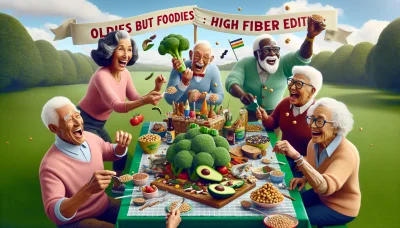High fiber low sugar foods Quiz
Test Your Knowledge
Question of
Understanding High Fiber, Low Sugar Foods
The Benefits of High Fiber Intake
High fiber foods are not just good for your gut; they're a powerhouse for overall health. Fiber keeps the digestive system running smoothly, preventing constipation and supporting a healthy microbiome. It's like having an internal cleaning crew working around the clock to keep you feeling great.
But it doesn't stop there! By making you feel fuller longer, fiber is a secret weapon in managing weight. Imagine eating a meal and feeling satisfied all afternoon that's the magic of fiber. Plus, it helps prevent snack attacks by keeping those hunger pangs at bay.
Now, let's talk long-term payoffs: a diet high in fiber can reduce your risk of developing nasty chronic diseases like heart disease, type 2 diabetes, and colorectal cancer. It's like an insurance policy for your health that you can eat!
Improved Digestive Health
Fiber-rich foods are like a workout for your digestive system, keeping everything moving and grooving. They add bulk to your stool, which makes it easier to pass goodbye constipation! Plus, they help maintain a balanced environment in your gut, which is crucial for overall health.
Think of fiber as the ultimate multitasker: it also helps to regulate the body's use of sugars, keeping hunger and blood sugar in check. Who knew that something as simple as eating more fruits and veggies could make such a difference?
Enhanced Weight Management
Fiber is the unsung hero of weight management. By slowing down digestion, it gives your body time to signal when it's full, meaning fewer calories consumed without even trying! It's like having an automatic portion control agent right there in your stomach.
Plus, because high-fiber foods require more chewing time, you'll slow down and enjoy your meals more mindfulness and satisfaction in every bite. Get ready to say goodbye to mindless munching and hello to a happier waistline!
Lower Risk of Chronic Diseases
A diet rich in high-fiber foods is like a shield against chronic diseases. Studies show that people who indulge in plenty of fiber have lower risks of heart disease and type 2 diabetes. It's incredible how much protection can come from whats on your plate!
Beyond just heart health and diabetes prevention, high-fiber diets are also linked with a reduced risk of certain types of cancer. This includes cancers of the colon and breast further proof that good food choices can be powerful medicine.
Identifying Low Sugar Benefits
Cutting back on sugar might just be one of the best things you can do for your body. Without all those extra sugars wreaking havoc on your bloodstream, you'll maintain stable blood sugar levels throughout the day no more energy crashes or mood swings!
Ditching sugary snacks reduces your risk of developing type 2 diabetes by keeping insulin levels steady. It also means better dental health fewer cavities! You'll feel like a superhero with the power to resist sugary temptations.
Stabilized Blood Sugar Levels
- *
- Maintain Consistent Energy: By avoiding spikes in blood sugar, you'll enjoy sustained energy all day long. *
- Better Mood Regulation: Steady blood sugar helps prevent mood swings and irritability associated with highs and lows. *
- Improved Concentration: Stable glucose levels mean better focus and mental clarity wave goodbye to that mid-afternoon brain fog. *
- Natural Appetite Control: When blood sugar doesn't spike from sugary foods, cravings decrease, aiding natural appetite regulation. *
- Long-Term Health Protection: Consistently controlled blood sugar reduces the risk of diabetes-related complications over time.
Reduced Risk of Diabetes
Sugar may taste sweet but its effects on health can be bitter. Lowering sugar intake slashes the risk of developing type 2 diabetes by helping to regulate insulin sensitivity. This is critical because once insulin resistance sets in, reversing it is no piece of cake.
Decreased Cravings and Better Appetite Control
Say goodbye to those sudden sugar cravings that lead you straight to the cookie jar! A low-sugar diet helps balance hormone levels related to hunger signals. No more being betrayed by your own body's false alarms telling you it's snack time when it's not.
Balancing Fiber and Sugar in Your Diet
Essential Foods for a High Fiber, Low Sugar Diet
Vegetables: A Nutrient Powerhouse
Vegetables are the cornerstone of any high fiber, low sugar diet. They're packed with vitamins, minerals, and of course, dietary fiber, while being low in calories and sugar. Integrating a variety of vegetables into your meals can transform your health!
Leafy Greens and Their Fiber Content: Leafy greens such as spinach, kale, and Swiss chard are fiber-rich and incredibly beneficial for digestive health. These greens are also low in sugar, making them perfect for maintaining stable blood sugar levels.
Cruciferous Vegetables for Balanced Meals: Broccoli, cauliflower, and Brussels sprouts belong to the cruciferous family and are stellar for a high-fiber diet. They help keep you full longer without the added sugars.
Root Vegetables as Versatile Ingredients: Root vegetables like carrots, beets, and sweet potatoes offer a hearty dose of fiber. Their natural sweetness satisfies cravings without causing a sugar overload.
Fruits: Natural Sweetness Without the Sugar Spike
Fruits can be tricky on a low-sugar diet but choosing the right ones is key. Opt for fruits that have a lower glycemic index to enjoy sweetness without significantly impacting blood sugar levels.
Berries: Low Sugar and High Fiber Options: Berries such as strawberries, raspberries, and blackberries have less sugar than other fruits and are bursting with fiber. They're ideal for snacking or adding to breakfast dishes.
Apples and Pears: Whole Fruit Benefits: Eating apples and pears with their skin on provides you with an excellent source of fiber. These fruits help regulate digestion while keeping sugar intake minimal.
Citrus Fruits: Fiber with a Vitamin C Boost: Oranges and grapefruits offer a refreshing taste along with fiber and vitamin C. They can brighten up any meal while contributing to your daily fiber goals.
Whole Grains: Sustainable Energy Sources
Moving away from refined grains to whole grains is a fantastic way to increase fiber intake. Whole grains provide long-lasting energy without the blood sugar spikes associated with processed grains.
Oats: A Heart-Healthy Staple: Oats are incredibly versatile and one of the best sources of soluble fiber. This heart-healthy grain can reduce cholesterol levels and keep you feeling full until your next meal.
Quinoa: A Complete Protein Choice: Quinoa isn't just rich in fiber; it's also a complete protein containing all nine essential amino acids. It's an excellent grain alternative for anyone looking to reduce their sugar intake while maintaining balanced nutrition.
- Oats should be chosen in their least processed form (steel-cut or old-fashioned) to maximize their health benefits.
- Incorporate quinoa into salads or use it as a base for stir-fries to boost your daily fiber intake effortlessly.
- Barley can be used in soups and stews where it absorbs flavors beautifully while thickening the broth naturally.
- Avoid pre-packaged flavored oatmeals which often contain added sugars; instead, flavor your oats with fresh fruit or spices like cinnamon.
- Rinse quinoa thoroughly before cooking to remove its natural coating called saponin, which can impart a bitter taste if left unwashed.
- To retain most nutrients in barley, opt for hulled barley over pearl barley as it undergoes minimal processing.
Barley: Versatile and Nutrient-Dense: Barley is another fantastic whole grain that's not only rich in fiber but also contains important nutrients like selenium, magnesium, and vitamins B1 and B3. It's perfect for adding substance to meals while keeping blood sugar levels stable.
Navigating Diets with Specific Requirements
Gluten-Free High Fiber, Low Sugar Options
Adopting a gluten-free diet doesn't mean you have to compromise on fiber or taste. There are abundant high-fiber, low-sugar options that cater to this need. By choosing the right foods, you can enjoy a varied and nutritious diet without feeling restricted.
One of the key challenges for gluten-sensitive individuals is finding whole grains that provide essential nutrients. Luckily, there are safe and delicious alternatives like quinoa, buckwheat, and brown rice that pack a fiber-rich punch.
Safe Grains and Seeds for Gluten Sensitivity
Grains such as amaranth, millet, and sorghum are fantastic gluten-free options that don't skimp on fiber. These grains can be used in a variety of dishes from breakfast porridges to hearty dinner bowls. Seeds like flaxseed and chia also offer a fiber boost and are easily incorporated into smoothies or yogurt.
Gluten-Free Breads and Pastas
The market for gluten-free products has exploded with breads and pastas now widely available. When selecting these products, focus on those made with nutrient-dense flours like almond or coconut flour to maximize your dietary fiber intake.
Snacks and On-the-Go Solutions
Finding snacks that satisfy the criteria of being high in fiber but low in sugar can be tricky. Look for whole food snacks such as fresh fruit with nut butter or homemade trail mixes. These options are not only nutritious but also deliciously satisfying.
Vegan and Vegetarian-Friendly Choices
Vegans and vegetarians often seek out high-fiber options that align with their dietary choices. The abundance of plant-based foods rich in fiber makes it easy to maintain a balanced diet while adhering to these dietary restrictions.
Plant-Based Proteins with High Fiber
- Lentils: A powerhouse of nutrition, lentils are full of protein and fiber.
- Chickpeas: Versatile and satisfying, chickpeas can be included in salads, soups, or hummus.
- Black Beans: Great for heart health, black beans can be used in tacos, burritos, or as part of a bean salad.
- Quinoa: Though technically a seed, quinoa is full of protein and can serve as a base for many dishes.
- Tofu: Made from soybeans, tofu is adaptable to many recipes while providing both protein and fiber.
Dairy Alternatives and Nutritional Considerations
Dairy alternatives like almond milk or coconut yogurt are excellent for those avoiding animal products. It's important to check labels for added sugars or fortifications to ensure you're getting the necessary nutrients without unwanted extras.
Balancing Macronutrients in Plant-Based Diets
A well-rounded vegan or vegetarian diet should include a balance of macronutrients proteins, fats, and carbohydrates. Incorporating a variety of plant-based foods ensures you get all essential amino acids and an adequate intake of healthy fats alongside your fibers.
Paleo Diet Adaptations for Fiber Intake
The Paleo diet emphasizes whole foods but may fall short on fiber if not carefully planned. With the inclusion of certain nuts, seeds, fruits, and vegetables, following Paleo guidelines while maintaining high dietary fiber is achievable.
Nuts and Seeds as Snack Options
Nuts like almonds and walnuts together with seeds such as pumpkin seeds provide both healthy fats and fibers. They make excellent snacks or additions to meals and help keep hunger at bay while following the Paleo diet.
Paleo-Friendly High Fiber Vegetables
Vegetables like broccoli, Brussels sprouts, and carrots are not only Paleo-friendly but also rich in fiber. They can be enjoyed raw as snacks or cooked into savory dishes to enhance your daily fiber intake while keeping true to Paleo principles.
Fruit Selections for Optimal Health
Fruits such as berries, apples, and pears have a place in the Paleo diet as they offer natural sweetness along with beneficial fibers. These fruits can be consumed fresh or used creatively in recipes to add flavor without processed sugars.
Meal Planning for a Balanced Diet
Breakfast Ideas to Kickstart Your Day
High Fiber Cereals and Toppings: Begin your day with a bowl of high fiber cereal! Not only does it aid digestion, but it also keeps you feeling full until lunch. Top it with fresh berries or nuts to add natural sweetness and essential fats.
Smoothies with Low Sugar Impact: Whip up a smoothie that's low in sugar but high in flavor. Combine leafy greens, a small portion of fruit, and protein powder. This liquid meal is perfect for on-the-go mornings and provides a nutrient-packed start to the day.
Protein-Packed Breakfasts for Sustained Energy: Scramble eggs or prepare an omelet stuffed with vegetables for a protein-rich breakfast. It fuels muscle repair and offers sustained energy. Pair it with whole-grain toast for a balanced meal.
Lunch Options That Keep You Full Longer
Salads with a High Fiber Twist: Elevate your salad game by incorporating kale, spinach, or chard. Add beans or chickpeas for protein and sprinkle seeds or nuts for healthy fats. This combination ensures you stay full and energized throughout the afternoon.
- Mix dark leafy greens like kale and spinach for maximum nutrients.
- Add a source of lean protein such as grilled chicken or tofu.
- Toss in a variety of colorful vegetables to make your salad visually appealing and nutritionally diverse.
- Top off with seeds or nuts instead of croutons for added texture without the extra carbs.
- Dress lightly with olive oil and vinegar to avoid excessive calories from creamy dressings.
Soups Packed with Vegetables and Legumes: A hearty soup can be both comforting and filling. Load yours with veggies, beans, or lentils. They're not only packed with fiber but also proteins that help curb hunger pangs until dinner time.
Whole Grain Wraps and Sandwiches: Choose whole grain wraps or breads for your midday sandwiches to ensure you get complex carbs and fiber. Fill them with lean meats, plenty of veggies, and hummus or avocado spread as healthy fat options.
Dinner Recipes for a Satisfying Evening Meal
Lean Proteins with Fiber-Rich Sides: For dinner, serve up lean proteins like fish or chicken beside quinoa, brown rice, or sweet potatoes. These sides are not only delicious but are also brimming with fiber which helps in slowing down glucose absorption, keeping you satisfied longer.
Stir-Fries That Maximize Vegetable Intake: Stir-fries are quick to prepare and can be loaded with an array of colorful vegetables. Toss in some shrimp or tofu for protein. Use low-sodium soy sauce or tamari to keep the salt content in check while enhancing flavor.
Hearty Stews and Casseroles: End your day with a warm stew or casserole. These dishes can be prepared in bulk, saving time throughout the week. Include a variety of vegetables along with beans or lean meats to ensure each spoonful is both tasty and nourishing.
Snacking Smart: High Fiber, Low Sugar Choices
Savory Snacks That Satisfy Cravings
Ditch the empty calories and dive into the crunchy goodness of vegetable chips! Made from kale, beets, or sweet potatoes, these chips offer a fiber-rich alternative to traditional snacks. Paired with hummus or salsa, they provide a nutrient-packed punch to satisfy those savory urges.
Roasted nuts and seeds are not just delicious; they're a powerhouse of health benefits. Almonds, walnuts, and pumpkin seeds deliver protein and heart-healthy fats. Opt for unsalted versions to keep sodium in check and your energy levels stable throughout the day.
Who can resist the classic combo of cheese and whole grain crackers? This duo is perfect for a quick snack that's both satisfying and smart. Choose low-fat cheeses and crackers high in fiber for a guilt-free indulgence that keeps you full and focused.
Sweet Treats Without the Guilt
Fruit-based desserts are your best friends when sugar cravings strike. Think baked apples with cinnamon, berry parfaits, or banana ice cream. These treats are naturally sweetened by fruits, making them an excellent choice for a fiber-filled dessert.
Dark chocolate is a decadent way to get your sweet fix without the sugar crash. Look for options with at least 70% cocoa content; they contain less sugar and are packed with antioxidants. A small square can go a long way in satisfying your sweet tooth!
Homemade baked goods give you control over what goes into your treats. Swap out white flour for whole wheat, use ripe bananas or applesauce instead of sugar, and add oats or nuts for extra texture and fiber. These small changes make a big impact on nutritional value!
Portable Snacks for Busy Lifestyles
Energy bars can be a convenient option when you're on the gojust watch out for added sugars! Choose bars with natural ingredients like whole grains, nuts, seeds, and dried fruit to ensure you're getting quality fuel for your busy day.
- Read Labels Carefully: Look beyond the marketing claims and check the nutrition facts for sugar content.
- Keep it Whole: Choose snacks made from whole foods to maximize nutrient intake.
- Portion Control: Pre-packaged single servings prevent overeating.
- Diversity Matters: Rotate between different types of snacks to get a variety of nutrients.
- Preparation is Key: Spend time preparing snacks in advance to avoid unhealthy choices.
Nut butter packets are another fantastic snack that's easy to carry around. Almond butter or peanut butter packs provide healthy fats and protein that keep hunger at bay. Pair them with an apple or banana for an instant energy lift.
Fresh fruit and vegetable packs are unbeatable when it comes to snacking convenience. Carrot sticks, cherry tomatoes, grapes, or apple slicesthese are all easy to prep ahead of time and perfect for snacking on the run without any added sugars or preservatives.
Overcoming Common Dietary Challenges
Dealing with Sugar Cravings Effectively
We all know the siren call of sugar, but combating those cravings is essential for a healthy lifestyle. Sugar, while tantalizing to the taste buds, can be a major obstacle in achieving dietary goals. Understanding the root of these cravings and implementing strategic changes can lead to successful management and reduction of sugar intake.
Healthy Alternatives to Sugary Snacks
Replacing sugary snacks with healthier options doesn't have to be a joyless endeavor. Fruits, yogurt, and dark chocolate are excellent substitutes that satisfy sweet cravings without derailing your diet. Incorporating these alternatives can make a significant difference in reducing sugar consumption.
Behavioral Strategies to Reduce Cravings
To effectively reduce sugar cravings, it's critical to identify triggers and establish new routines. Mindful eating and distraction techniques are powerful tools in this battle. By recognizing patterns and replacing them with healthier behaviors, you can take control over your cravings.
Hydration's Role in Managing Sweet Tooth
Never underestimate the power of hydration! Often, what we perceive as a craving for sweets is actually thirst in disguise. Keeping well-hydrated can help mitigate sweet tooth urges and is an essential component of any dietary plan.
Dining Out on a High Fiber, Low Sugar Diet
Eating out doesn't have to spell disaster for your high fiber, low sugar diet. With a bit of planning and savvy decision-making, you can enjoy dining experiences without compromising on your health objectives.
- Making Smart Menu Choices: Scan the menu for dishes rich in vegetables, whole grains, and lean proteins. Steer clear of items labeled as "crispy" or "glazed" as they often indicate higher sugar content.
- Questions to Ask Your Server: Don't hesitate to inquire about meal preparation methods or request substitutions like dressing on the side it's your diet and your right!
- Strategies for Buffet and Family-Style Meals: Fill your plate first with high-fiber foods such as salads and vegetables before exploring other options. This helps ensure you stick to your dietary goals even when faced with an abundance of choices.
Managing Social Situations and Peer Pressure
Social gatherings pose unique challenges for maintaining dietary discipline. The key is preparation and confidence in your lifestyle choices.
Communicating Dietary Preferences
Candid communication about your dietary preferences can prevent awkward situations at social events. Friends and family are more likely to support your choices if they understand the reasons behind them.
Bringing Your Own Dish to Share
Taking control by bringing a dish that fits within your diet not only ensures you'll have something appropriate to eat but also introduces others to delicious, healthy alternatives.
Staying True to Your Diet During Celebrations
Celebrations don't have to derail your progress. Focus on the event's social aspects rather than the food, savor small portions of special treats without guilt, and remember why you're committed to your diet - it's all about celebrating health!
Tracking Progress and Maintaining Motivation
Setting Realistic Dietary Goals
Embarking on a dietary transformation starts with setting attainable objectives. Crafting realistic goals provides a clear direction and prevents the overwhelming feeling that often accompanies drastic lifestyle changes. It's essential to tailor your ambitions to your individual lifestyle, ensuring they seamlessly integrate with your daily routine.
Short-term milestones are the secret ingredients to achieving long-term dietary success. They break down the intimidating end-goal into manageable chunks, making the journey seem less daunting. These mini-goals should be specific, measurable, and time-bound, providing a roadmap to your ultimate destination.
Every small victory is a step closer to your grand goal and deserves celebration. Recognizing these achievements fuels further progress and reinforces positive behavior. Whether it's resisting a tempting treat or hitting a weekly exercise target, these triumphs are pivotal morale boosters.
Goals are not set in stone; they are dynamic and should evolve as you progress. Regularly reviewing and adjusting your goals ensures they remain challenging yet achievable. Flexibility here is key to staying engaged with your dietary objectives without becoming disheartened.
Monitoring Your Dietary Intake
To ensure you're on track, monitoring what you eat is fundamental. Food journals or diet tracking apps provide insightful data on your eating habits, making it easier to stick to your plan. Consistent logging acts as both a motivator and an accountability tool, keeping you focused on your dietary goals.
A common obstacle in diet management is misjudging portion sizes. Understanding what constitutes a serving is crucial for accurate tracking. This knowledge empowers you to make informed decisions about the quantity of food you consume, directly impacting your dietary success.
- Mistake: Not measuring portions can lead to overeating.
- Tip: Use measuring cups or a digital food scale for precision.
- Mistake: Ignoring liquid calories which can add up quickly.
- Tip: Track all beverages, not just solid foods.
- Mistake: Forgetting to log snacks can result in unnoticed extra calories.
- Tip: Keep healthy snacks at hand and record every bite.
Dietary slip-ups are inevitable but learning from them is what matters most. Analyzing why they occurred helps prevent future mistakes and keeps you moving forward. Remember that occasional indulgences are part of a balanced lifestyle and should be treated as learning opportunities rather than failures.
Staying Inspired on Your Dietary Journey
Finding a community of like-minded individuals can significantly bolster your motivation. Support groups offer camaraderie and understanding, providing an environment where sharing experiences and tips becomes a source of inspiration. Social media platforms are excellent places to connect with such supportive communities.
Inspirational success stories have the power to reignite passion for your dietary goals when enthusiasm wanes. These narratives remind us that our objectives are attainable and provide practical insights into overcoming common challenges. Seek out blogs, books, or documentaries that resonate with your journey for continual motivation.
The world of nutrition is ever-evolving, with new research emerging regularly. Staying informed about the latest dietary trends and scientific findings keeps the journey exciting and educational. Continuous learning not only empowers you with knowledge but also helps adapt your diet plan to include novel insights for enhanced well-being.












